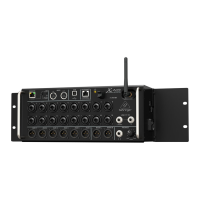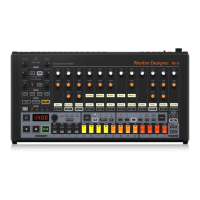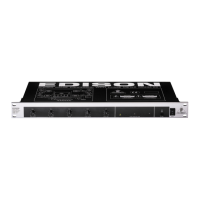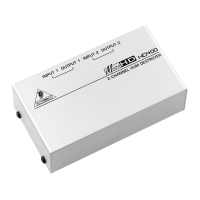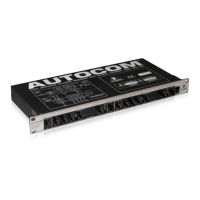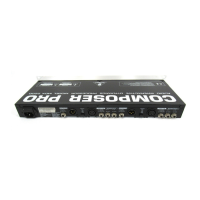15. Output channel buttons, with which you can enter the outputs 1-6 or mute or reactivate individual outputs in
MUTE mode.
16. Use the POWER switch to put your DCX2496(LE) into operation. The POWER switch should always be in the
“Off” position when you are about to connect your unit to the mains.
17. This is the FUSE HOLDER of your DCX2496(LE). Blown fuses must be replaced by a fuse of the same type
and rating.
18. The mains connection is an IEC receptacle. An appropriate power cord is included.
19. The 9-pin RS-232 interface allows you to connect your DCX2496 to a computer. This enables you to save and
load files, update the DCX2496 operating software, or remotely control one or several ULTRADRIVE PRO units
from a PC. Free editor software can be downloaded at behringer.com.
20. When you have daisy-chained several ULTRADRIVE PRO via the LINK connectors (see (21)), please press the
TERM switch on the first and last unit of the chain, to avoid data reflections and transmission errors.
21. Use the LINK connectors A and B (RS-485 network interface) and a commercially available network cable to
daisy-chain several ULTRADRIVE PROs.
22. Balanced XLR output connectors for output channels 1-6. Connect your power amps here.
23. Balanced XLR input connectors A-B / A-C are used for connecting input signals.
DCX2496:
Input A can also be used for digital AES/EBU input signals. Input C can be used for line signals or for
connecting a measuring microphone. If AUTO ALIGN has been enabled in the SETUP menu, input C will be set
for mic levels automatically. Additionally, phantom power for the measuring microphone will be switched on.
ULTRADRIVE PRO DCX2496/ULTRADRIVE DCX2496LE Quick Start
This chapter is for those who cannot wait to use their new DCX2496(LE) in a practical application. You will find a
description of how you can explore your DCX2496(LE) and its versatile and intuitive features below. This chapter is
just a starting point for future excursions. So, please read the entire user’s manual to take full advantage of all your
DCX2496(LE)’s features and functions.
Check Out behringer.com for Full Manual
Selecting an Output Configuration
Press the SETUP button to call up the SETUP menu. On the first menu page, select an output configuration (OUT
CONFIGURATION) to determine which outputs are used for which frequency ranges. One mono and three stereo
configurations are available.
The mono configuration allows you to split the input signal into six different frequency ranges. The stereo
configurations allow a maximum of three different frequency ranges per stereo side. The abbreviations L, M and H
stand for Low, Mid and High Speaker.
Setting Crossover Frequencies
In order to assign dedicated frequency bands to the output channels, you have to define the crossover frequencies
(X-Over) for each of them. The crossover frequencies determine the upper and lower limits of a frequency band,
which allows you to clearly separate the outputs from each other in terms of frequency.
Press the corresponding OUT button (1-6) and select menu page 2/8 using the PAGE buttons. With the parameters

